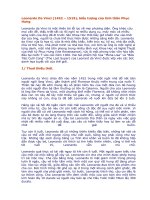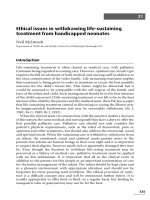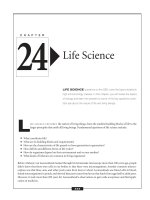leonardo da vincis life
Bạn đang xem bản rút gọn của tài liệu. Xem và tải ngay bản đầy đủ của tài liệu tại đây (34.22 KB, 1 trang )
The Renaissance was one of the most important movements in the history of the world. Numerous
breakthroughs were made during this time. The renaissance took place during the 14th, 15th, and
16th centuries. Leonardo da Vinci (1452 - 1519) was known for his art during that time. Along
with being a painter da Vinci was a sculptor, an engineer, an architect, and a scientist. Da Vinci
was born during the Renaissance and after his death he influenced many other sculptors, and
painters like Michelangelo.
Leonard was born in Vinci, Tuscany. Leonardo was a part of a very wealthy family. In the
mid-1460s, his family settled in Florence, where Leonardo was given the best education that
Florence could offer. He quickly advanced socially and intellectually. In about 1466, he was
apprenticed to Andrea del Verrocchio as a garzone, or studio boy, where he was introduced to
many activities from the painting of altarpieces to the creation of bronze and marble sculptures. In
1472, he entered the Painters Guild of Florence, and in 1476, he was still considered the assistant
of Verrocchio. In 1478, he became his own master and many chapels were giving him offers to
draw altarpieces. Leonardo's world-famous work (Mona Lisa) is very well know because of its
unique techniques and the mysterious smile on the face of the subject. This work is an example of
two techniques, sfumato, and chiaroscuro. Leonardo was one of the first great masters of these
techniques. Sfumato is the blurring of sharp outlines that usually blends into another color, in this
work sfumato is used on the robe that the subject is wearing as well as on her smile. Chiaroscuro
is the use of light and shade in a pictorial representation. This is believed to be the cause of the
puzzling smile on the face of his model.
Another one of his famous pieces is "The Last Supper". This is the drawing of the famous scene
where Jesus Christ announced to his students that one of them is going to betray him. It is called
"The Last Supper" because that was the last supper of Jesus Christ before his crucifixion. This
work is more known to the followers of the Christian beliefs.
None of Leonardo's known sculptures have been completed so the only way to see his approach to
three-dimensional art is from his drawings. The same things apply to his architecture. There is no
known fact why his sculptures were never built but judging from his drawings, he shows an
excellent use of massive forms, visibility of expression, and the great knowledge of ancient
Roman Architecture.
Leonardo was also known for his scientific and theoretical projects. He understood better then
anyone in the next century how important observation is in science. Sadly, just like he never
finished his sculptures, his scientific projects were not completed. His theories are written down in
numerous notebooks, but because they were not easily readable, these works were not developed
during the 16th century. Those notes were written in mirror script. If those works were printed in
his time, they would have revolutionized the science of the 16th century by a lot, and an airplane
might have been invented a whole lot earlier than 1903. Leonardo actually anticipated many
discoveries of modern times. In anatomy, he studied the circulation of the blood and the action of
the eye. He made discoveries in meteorology and geology, learned the effect of the moon on the
tides, thought of the modern theory of the continent formation, and guessed on the nature of fossil
shells. He was one of the creators of hydraulics and probably invented the hydrometer. He
invented many machines, many of which are useful today; among them is an underwater diving
suit. His flying machine drawings, although they would not be able to fly, were the base for the
sound principles of aerodynamics.
Leonardo da Vinci was very important to the Renaissance because he influenced many sculptors
and painters of the future time period. He also made many advances in science, so without
Leonardo many things such as an airplane would not be invented even now.









